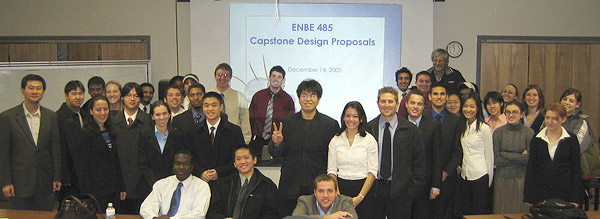|
|
 |
|
Syllabus for ENBE 485 Capstone Design I Fall 2005
Satisfactory completion of ENBE 485 should demonstrate that students can: 1. Starting with an idea develop design specifications for a design against which it can later be tested.
2. Carry out the design of a device or computer program to accomplish a specific task or group of tasks.
3. Develop on paper the drawings and description needed for a shop or other appropriate group to build the device or program.
4. Select materials, subunits, components, etc. needed to produce the plans for a device or program.
5. Understand the basics of graphics and demonstrate ability to use them effectively to communicate with others.
6. Demonstrate effective oral and written communication of a design to technical and non-technical audiences.
Course Schedule: Introduction and project introduction Change and Creativity The Engineering Design process The Engineering Design process (Concept Proposal Due to 485 Instructor and Project Advisor) The Engineering Design Process Aesthetics/Human Factors Manufacturing Ethical and environmental Considerations Patents, Copyrights, Trade Marks, and Trade Secrets Selling your Design and Yourself Seven Habits of Highly Successful people Written Proposal Due and Presentations Given in Class In Class Presentations Job hunting (Board of Directors Responds) Examination Final Project Report Due (One copy to course instructor and one to project advisor)
Fall 2005 ENBE 485 Class
Fall 2005 ENBE 485 Group (Advisor)
ENBE 486 Capstone Design II Spring 2005
“Design of a Body Temperature Regulated Electric Blanket” Yang Tao, Advisor Shaya Jamshidi, Sara Lustusky, Arthur Redding, and Jasveer Singh
The design provided is a DC-powered blanket that senses the consumer’s body temperature and regulates an electric blanket to heat only as required. More specifically, the objective of the body temperature regulated electric blanket is to safely increase the temperature of the blanket according to logic in a system that is portable. All design objectives were met by designing a DC-powered system that used thermistors, NOR gates and operational amplifiers to sense and compare the temperatures of the blanket to the body. The overall system was under budget. Although the final electric blanket has met design specifications, future recommendations for its successors include the incorporation of wireless technology, computer logging system, peripheral interface controllers, and car adaptors to name a few.
|
| [Home] [Biography] [Research] [Teaching] [Industry Exp.] [Lab. Personnel] [Collaborators] [Publications] [Links] |

